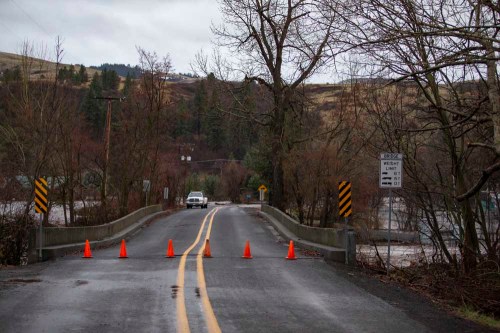CTUIR, Umatilla County pursuing quicker fix to Thorn Hollow Bridge
Published 8:00 am Tuesday, October 6, 2020

- A bridge in Thorn Hollow bows as the Umatilla River rises below it on Feb. 6, 2020.
MISSION — At an estimated replacement cost of $4.6 million, the Thorn Hollow Bridge left impassable by the raging waters that flooded the Umatilla Indian Reservation and Umatilla County in February isn’t on track to be replaced until at least 2025.
During a meeting between the Confederated Tribes of the Umatilla Indian Reservation’s Board of Trustees and the county board of commissioners Wednesday, Sept. 30, the two entities focused on expediting that replacement while establishing a better relationship for joint recovery efforts from February’s floods.
Trending
“We’re looking at the future and trying to figure out what our options are to make all the Umatilla County residents who live up there have options for safety,” said Sally Kosey, treasurer for the CTUIR Board of Trustees.
Without the Thorn Hollow Bridge in place, residents have had their direct access to Highway 11 cut off. The CTUIR is concerned that in the event of wildfires or other emergencies, the community’s ability to evacuate has been significantly hindered without that access.
“That’s a real concern for us because, not only do tribal members live up there but nontribal members live up there,” said Kat Brigham, chair of the CTUIR Board of Trustees. “And they’re having big changes in their lives.”
The problem is the county says it doesn’t have the money to fund the project itself, even with the hope of eventual reimbursement from the Federal Emergency Management Agency.
“In the county road department, we just don’t have big enough pockets for $4.6 million,” said Tom Fellows, county roadmaster and public works director.
Fellows said the county explored funding through the federal bridge replacement program, but there wasn’t enough emergency funding for the project, either. But Fellows said the county had recently secured roughly $600,000 to begin designing a replacement for the bridge.
Trending
“That will get us a bridge design that’s ready to go,” he said.
The CTUIR questioned the county’s priorities in infrastructure repairs from the floods, noting the county had found a temporary bridge to reopen Harris Park earlier this year.
“We know it’d be an additional cost,” Kosey said. “But if we can get a temporary bridge to put at Harris Park to a dead end, surely there’s something we can do to help the people at Thorn Hollow Bridge.”
Fellows said the bridge for Harris Park was a loan from Lane County and that it was only needed to cover 40 feet, unlike the 200 feet needed where Thorn Hollow Bridge spans. For a temporary solution, Fellows said a foot bridge of some kind may be able to be installed but he hadn’t found a temporary option that would accommodate vehicles.
Jill-Marie Gavin, an at-large member of the CTUIR board of Trustees, also expressed some of the Tribes’ frustrations with the lack of communication from the county until the Sept. 30 meeting and the desire to build a stronger collaborative relationship moving forward.
Umatilla County Commissioner John Shafer agreed that the relationship can and should be stronger, and said holding more joint meetings between the two government entities going forward would be one way to work toward that.
The boards agreed to schedule quarterly meetings every three months moving forward as each work to recover from recent disasters, with the next meeting planned for Dec. 16.
In the meantime, the boards also agreed to each look to additional funding sources, while combining any future lobbying efforts to Gov. Kate Brown and the Oregon Legislature in exploring quicker options to replace Thorn Hollow Bridge.
“I think we can come out of this with a sort of a joint group that can pursue all kinds of targets,” said Umatilla County Commissioner George Murdock. “And if we have a joint proposal between the county and Tribes, I think that goes a lot further in Salem.”









